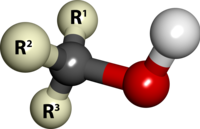
Photo from wikipedia
Cinnamaldehyde was immobilized to O-amine functionalized chitosan via a coupling reaction. Fourier transform infrared spectroscopy confirmed N-cinnamyl substitution. Wetting analyses demonstrate more hydrophobicity in the N-cinnamyl substituted O-amine functionalized chitosan… Click to show full abstract
Cinnamaldehyde was immobilized to O-amine functionalized chitosan via a coupling reaction. Fourier transform infrared spectroscopy confirmed N-cinnamyl substitution. Wetting analyses demonstrate more hydrophobicity in the N-cinnamyl substituted O-amine functionalized chitosan compared to chitosan or unsubstituted O-amine functionalized chitosan. Thermal gravimetric analysis and differential scanning calorimetry demonstrates that the prepared N-cinnamyl substituted O-amine functionalized chitosan exhibits higher thermostability than unmodified chitosan at temperatures in which polysaccharides are commonly stored and utilised. The N-cinnamyl substituted O-amine functionalized chitosan, against four different bacteria strains [two gram-positive (Staphylococcus aureus and Bacillus cereus) and two gram-negative (Escherichia coli and Pseudomonas aeruginosa)], displays promotion of inhibition activity against these bacterial strains. Finally, the antioxidative activity of the N-cinnamyl substituted O-amine functionalized chitosan was compared with those activities of chitosan and O-amine functionalized chitosan. This was evaluated by uninhibited and inhibited hyaluronan degradation and ABTS assay. The N-cinnamyl substituted O-amine functionalized chitosan shows a lower activity towards donating a hydrogen radical compared to chitosan or O-amine functionalized chitosan. On the other hand, the N-cinnamyl substituted O-amine functionalized chitosan exhibited a higher ability to scavenge the ABTS+ cation radical compared to chitosan and O-amine functionalized chitosan.
Journal Title: Carbohydrate polymers
Year Published: 2017
Link to full text (if available)
Share on Social Media: Sign Up to like & get
recommendations!